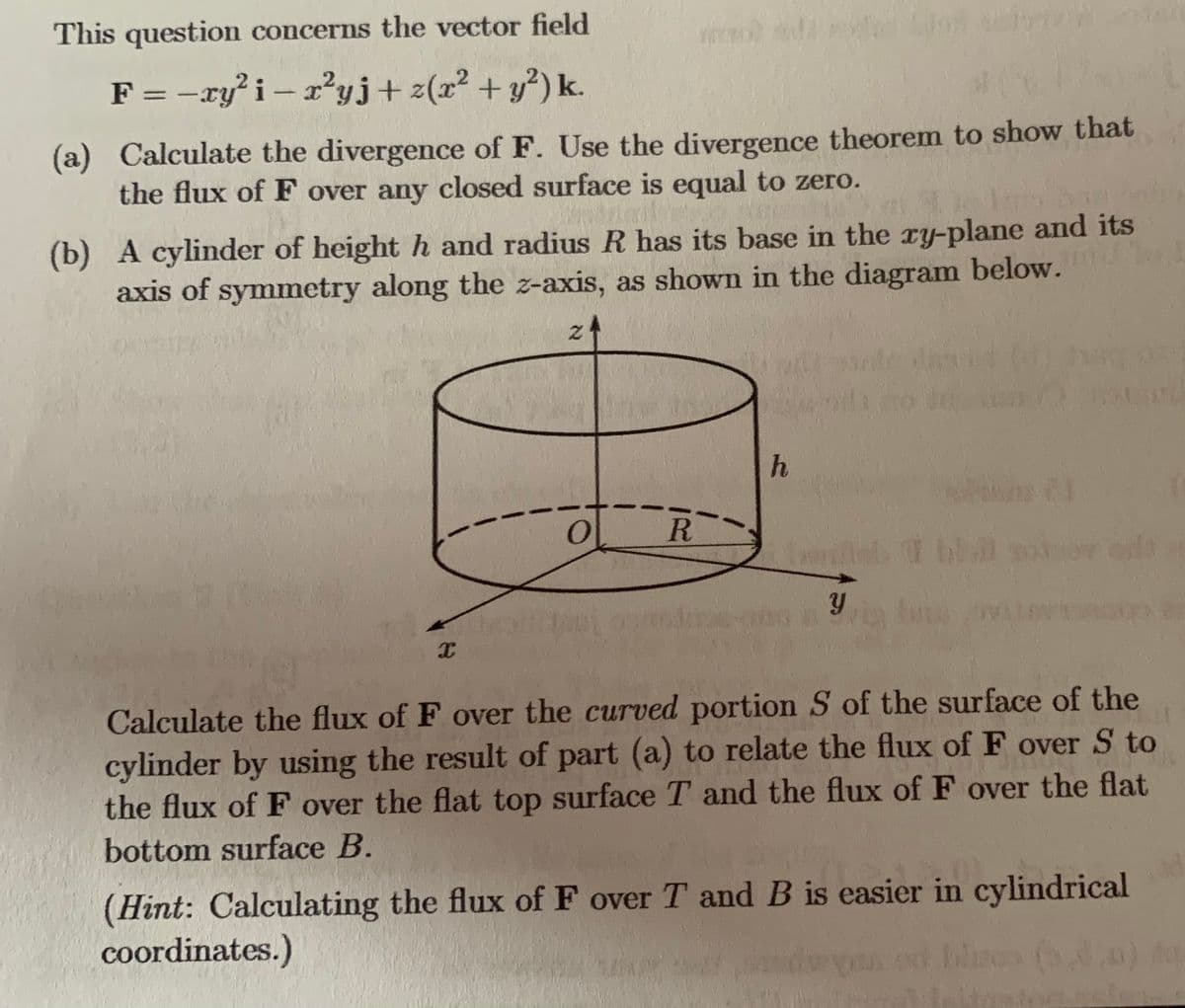This question concerns the vector field F = -xy²i-r²yj + z(x² + y²) k. (a) Calculate the divergence of F. Use the divergence theorem to show that the flux of F over any closed surface is equal to zero. (b) A cylinder of height h and radius R has its base in the xy-plane and its axis of symmetry along the z-axis, as shown in the diagram below. X O R h SE Calculate the flux of F over the curved portion S of the surface of the cylinder by using the result of part (a) to relate the flux of F over S to the flux of F over the flat top surface T and the flux of F over the flat bottom surface B. (Hint: Calculating the flux of F over T and B is easier in cylindrical coordinates.) yus od bless (s
This question concerns the vector field F = -xy²i-r²yj + z(x² + y²) k. (a) Calculate the divergence of F. Use the divergence theorem to show that the flux of F over any closed surface is equal to zero. (b) A cylinder of height h and radius R has its base in the xy-plane and its axis of symmetry along the z-axis, as shown in the diagram below. X O R h SE Calculate the flux of F over the curved portion S of the surface of the cylinder by using the result of part (a) to relate the flux of F over S to the flux of F over the flat top surface T and the flux of F over the flat bottom surface B. (Hint: Calculating the flux of F over T and B is easier in cylindrical coordinates.) yus od bless (s
Advanced Engineering Mathematics
10th Edition
ISBN:9780470458365
Author:Erwin Kreyszig
Publisher:Erwin Kreyszig
Chapter2: Second-order Linear Odes
Section: Chapter Questions
Problem 1RQ
Related questions
Question

Transcribed Image Text:This question concerns the vector field
F =−xy²i-x²yj + z(x² + y²) k.
(a) Calculate the divergence of F. Use the divergence theorem to show that
the flux of F over any closed surface is equal to zero.
(b) A cylinder of height h and radius R has its base in the xy-plane and its
axis of symmetry along the z-axis, as shown in the diagram below.
X
Z
0
R
h
At Th
Y
Fune
PI
Calculate the flux of F over the curved portion S of the surface of the
cylinder by using the result of part (a) to relate the flux of F over S to
the flux of F over the flat top surface T and the flux of F over the flat
bottom surface B.
(Hint: Calculating the flux of F over T and B is easier in cylindrical
coordinates.)
A4
Expert Solution
This question has been solved!
Explore an expertly crafted, step-by-step solution for a thorough understanding of key concepts.
Step by step
Solved in 6 steps

Recommended textbooks for you

Advanced Engineering Mathematics
Advanced Math
ISBN:
9780470458365
Author:
Erwin Kreyszig
Publisher:
Wiley, John & Sons, Incorporated

Numerical Methods for Engineers
Advanced Math
ISBN:
9780073397924
Author:
Steven C. Chapra Dr., Raymond P. Canale
Publisher:
McGraw-Hill Education

Introductory Mathematics for Engineering Applicat…
Advanced Math
ISBN:
9781118141809
Author:
Nathan Klingbeil
Publisher:
WILEY

Advanced Engineering Mathematics
Advanced Math
ISBN:
9780470458365
Author:
Erwin Kreyszig
Publisher:
Wiley, John & Sons, Incorporated

Numerical Methods for Engineers
Advanced Math
ISBN:
9780073397924
Author:
Steven C. Chapra Dr., Raymond P. Canale
Publisher:
McGraw-Hill Education

Introductory Mathematics for Engineering Applicat…
Advanced Math
ISBN:
9781118141809
Author:
Nathan Klingbeil
Publisher:
WILEY

Mathematics For Machine Technology
Advanced Math
ISBN:
9781337798310
Author:
Peterson, John.
Publisher:
Cengage Learning,

